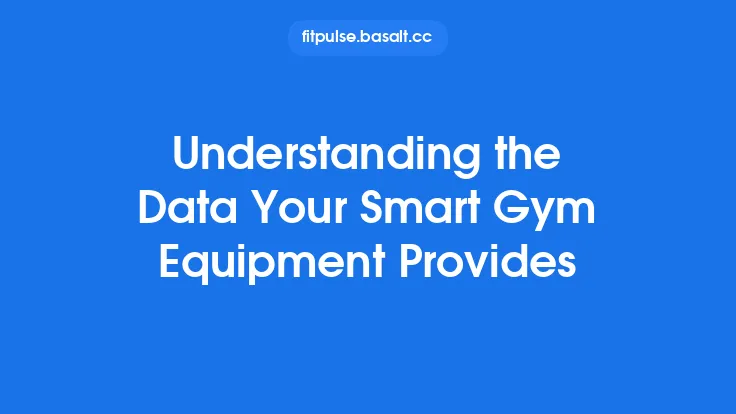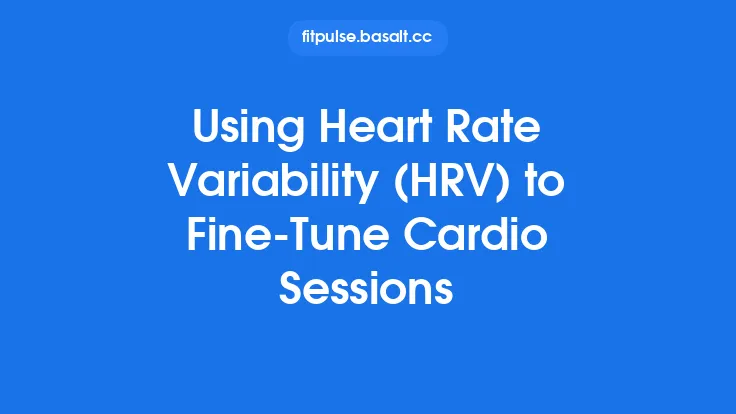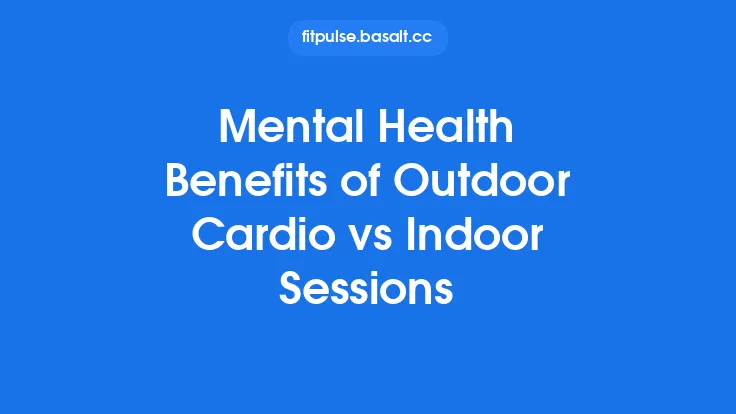Cardio workouts have become one of the most data‑rich activities in modern fitness. From GPS‑tracked routes and cadence to heart‑rate variability and perceived exertion, a single run or bike ride can generate thousands of data points. The real power, however, lies not in the raw numbers themselves but in the algorithms that turn those numbers into a cardio session that feels “just right” for each individual. Understanding how these algorithms work helps users appreciate the science behind the recommendations they receive and gives developers a roadmap for building more effective, personalized cardio experiences.
Data Foundations for Cardio Personalization
The first step in any personalization pipeline is gathering high‑quality data. In the cardio domain, the most common sources include:
| Source | Typical Metrics | Why It Matters |
|---|---|---|
| Wearable heart‑rate monitor | HR, HRV, resting HR | Direct proxy for effort and recovery state |
| GPS / GNSS module | Speed, distance, elevation, route geometry | Provides external workload and terrain difficulty |
| Power meter (cycling) | Instantaneous power, torque | Objective measure of mechanical output |
| Accelerometer / gyroscope | Cadence, stride length, ground‑contact time | Helps infer technique and fatigue |
| User‑entered inputs | RPE (Rate of Perceived Exertion), mood, sleep quality | Captures subjective state that may not be reflected in sensors |
| Historical performance logs | Past session durations, intensities, outcomes | Forms the baseline for trend analysis |
Collecting these signals at a high sampling rate (often 1 Hz or higher) creates a time‑series dataset that can be aligned, cleaned, and stored for downstream modeling. Data quality checks—such as detecting sensor dropout, outlier removal, and synchronization across devices—are essential to avoid feeding noisy inputs into the personalization engine.
Feature Engineering: Turning Raw Signals into Meaningful Inputs
Raw sensor streams are rarely used directly by machine‑learning models. Instead, they are transformed into engineered features that capture the physiological and biomechanical aspects of cardio performance.
- Temporal aggregates – average heart‑rate, peak power, and median speed over sliding windows (e.g., 30 s, 5 min) provide a smoothed view of effort.
- Variability indices – standard deviation of HRV, coefficient of variation of cadence, and speed fluctuation metrics highlight stability and fatigue.
- Gradient‑adjusted effort – combining elevation change with speed to compute “grade‑adjusted pace” (GAP) or “normalized power” for cyclists.
- Recovery markers – post‑exercise HR recovery slope, time to return to 50 % of HRmax, and HRV rebound.
- Session context – time of day, day of week, and weather conditions (temperature, humidity) that influence perceived difficulty.
- User profile embeddings – low‑dimensional vectors derived from clustering a user’s historical data, representing a “cardio phenotype” (e.g., “steady‑state endurance”, “high‑intensity interval enthusiast”).
These engineered features become the columns of the training matrix for supervised models or the state representation for reinforcement‑learning agents.
Core Algorithmic Approaches
Supervised Learning for Pace and Power Prediction
A common task is to predict the target pace (running) or power (cycling) that a user can sustain for a given duration. Regression models—ranging from linear regression with regularization (Ridge, Lasso) to gradient‑boosted trees (XGBoost, LightGBM) and deep neural networks—are trained on historical sessions where the input features describe the user’s current state and the output is the achieved average pace/power.
- Model input: recent HRV, last‑week training load, sleep quality, and environmental variables.
- Target: achievable pace for a 5‑km run or 30‑minute power zone.
Performance is measured with mean absolute error (MAE) or root‑mean‑square error (RMSE), and models are periodically retrained to incorporate the latest data, ensuring they adapt to fitness gains or regressions.
Clustering and Segmentation of Runner Profiles
Not every user benefits from the same algorithmic strategy. Unsupervised clustering (k‑means, DBSCAN, Gaussian Mixture Models) applied to the user‑profile embeddings can reveal natural groups such as:
- Long‑distance specialists – high endurance, low variability in HR.
- Interval lovers – frequent high‑intensity bursts, rapid HR recovery.
- Terrain‑adapted athletes – strong correlation between elevation gain and pace.
Once clusters are defined, each group can be assigned a tailored set of model hyperparameters or even distinct model families, improving overall recommendation relevance.
Reinforcement Learning for Adaptive Session Design
Reinforcement learning (RL) treats the cardio session as a sequential decision‑making problem. The algorithm (agent) selects the next intensity level (e.g., target pace for the next minute) based on the current state (features described above) and receives a reward that reflects how well the user adhered to the prescribed intensity while staying within safe physiological limits.
- State: real‑time HR, speed, fatigue estimate, and environmental context.
- Action: choose a target intensity band (e.g., “Zone 2”, “Zone 4”).
- Reward: combination of adherence score (how close actual effort matched target) and safety penalty (excessive HR, rapid HR spikes).
Policy‑gradient methods (e.g., Proximal Policy Optimization) or value‑based methods (Deep Q‑Networks) can be employed. The RL agent learns to “pace” the user, gradually increasing difficulty when the user consistently meets targets and backing off when physiological stress signals rise.
Hybrid Models and Ensemble Strategies
In practice, the best results often come from blending multiple approaches:
- Stacked ensembles combine predictions from gradient‑boosted trees, recurrent neural networks (RNNs), and RL‑derived policies, weighted by validation performance.
- Meta‑learners decide which base model to trust for a given user segment, using a gating network trained on segment‑specific error patterns.
These hybrid systems capture both the global trends learned from large datasets and the nuanced, real‑time adjustments needed during an active cardio session.
Real‑Time Adaptation During a Cardio Session
Personalization does not stop at the planning stage. Modern cardio platforms continuously ingest sensor streams and re‑evaluate the user’s state every few seconds. The adaptation loop typically follows these steps:
- Signal ingestion – raw HR, speed, and cadence are buffered in a sliding window.
- Feature update – compute the latest temporal aggregates and variability indices.
- State estimation – feed the updated features into a lightweight inference model (often a shallow neural net or decision tree) to estimate current fatigue and readiness.
- Policy query – the RL policy or rule‑based engine proposes the next intensity target.
- Feedback delivery – the app presents auditory or haptic cues (“increase pace slightly”, “recover in zone 2”).
- Safety check – a hard threshold (e.g., HR > 90 % of HRmax) can trigger an automatic downgrade or session termination.
Because inference must happen on‑device or with minimal latency, models are often quantized and optimized for mobile CPUs or dedicated AI accelerators.
Model Evaluation and Continuous Improvement
Robust evaluation ensures that personalization truly benefits the user and does not drift over time.
- Offline validation – split historical sessions into training/validation sets, compute MAE for pace prediction, and use silhouette scores for clustering quality.
- A/B testing – randomly assign users to “algorithm A” vs. “algorithm B” and compare objective outcomes such as session completion rate, average HR relative to target zones, and subjective satisfaction scores.
- Longitudinal metrics – track changes in VO₂max estimates, time‑to‑exhaustion, and consistency of adherence over weeks to assess whether the algorithm contributes to measurable fitness gains.
- Drift detection – monitor distribution shifts in input features (e.g., sudden change in average HRV) and trigger model retraining pipelines when drift exceeds predefined thresholds.
Continuous integration pipelines automate data preprocessing, model training, validation, and deployment, allowing the system to stay current with each user’s evolving fitness level.
Implementation Considerations for Fitness Platforms
When integrating cardio‑personalization algorithms into a commercial platform, several practical aspects must be addressed:
- Scalability – training on millions of sessions requires distributed data processing (e.g., Spark, Dask) and GPU‑accelerated model training for deep components.
- On‑device inference – to preserve battery life and reduce latency, models are often exported to TensorFlow Lite or Core ML formats, with quantization to 8‑bit integers.
- Privacy‑by‑design – while the article avoids deep ethical discussion, it is still advisable to store personally identifiable data locally when possible and use federated learning to improve models without centralizing raw user data.
- User control – expose simple sliders or preference toggles (e.g., “focus on endurance vs. speed”) that map to weighting parameters in the model’s loss function, giving users agency over the personalization direction.
- Explainability – provide concise rationales for recommendations (“Your recent HRV suggests you’re well‑recovered, so we increased the target pace by 5 %”) to build trust, even if the underlying model is a black box.
Future Directions in Cardio Personalization Algorithms
The field continues to evolve, and several emerging research avenues promise to refine how cardio sessions are tailored:
- Multimodal fusion – combining physiological signals with video‑based gait analysis or ambient sound classification to better understand terrain and fatigue.
- Meta‑learning – training models that can quickly adapt to a new user with only a handful of sessions, reducing the cold‑start problem.
- Causal inference – moving beyond correlation to identify which training adjustments truly cause performance improvements, enabling more prescriptive recommendations.
- Explainable reinforcement learning – generating human‑readable policies (“increase pace when HR stays below 150 bpm for 2 min”) to make RL decisions transparent.
- Edge‑centric continual learning – allowing on‑device models to update incrementally after each session without sending data to the cloud, preserving privacy while staying current.
By grounding personalization in solid data pipelines, thoughtful feature engineering, and a blend of supervised, unsupervised, and reinforcement‑learning techniques, modern fitness platforms can deliver cardio sessions that feel intuitively right for each user—pushing them just enough to improve while respecting their unique physiological limits.





